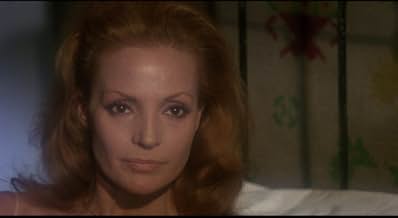Agrega una trama en tu idiomaA British novelist travels to Spain to visit his sister. However, when he arrives he discovers that she has been murdered by a gang of devil-worshiping bandits called the Devil's Cross.A British novelist travels to Spain to visit his sister. However, when he arrives he discovers that she has been murdered by a gang of devil-worshiping bandits called the Devil's Cross.A British novelist travels to Spain to visit his sister. However, when he arrives he discovers that she has been murdered by a gang of devil-worshiping bandits called the Devil's Cross.
Argumento
¿Sabías que…?
- TriviaThis was prolific director John Gilling's last film. He hadn't planned to make it, but he was on vacation in Spain when his friend, actor/director Paul Naschy, asked him to direct it for him.
- ConexionesReferenced in Rojo sangre (2004)
Opinión destacada
Often said to be the unofficial fifth chapter in the "Blind Dead" series, John Gilling's "La Cruz del Diablo" (The Devil's Cross) easily tops his predecessors, and is among the very best horror films to have come out of Spain. The story follows a writer who has a series of drug addicted hallucinations involving the Templars. When he goes to Spain visit his sister, only to find that she died by the time he got there, he decides to investigate, and tries to find a connection between her death and his horrifying visions. While many have called it a mere cash-in on Amando de Ossorio's infamous series, it's actually a much more accurate and throughly superior adaptation of the writings of Gustavo Adolfo Bécquer, which also served as inspiration for "Tombs of the Blind Dead". Like Béquer, less emphasis is given to the Templars themselves, and the whole affair is more of a character-driven piece, that is not devoid of symbolism and ambiguity. I have to give credit to Ossorio, since his Templars are much creepier than those presented here, but I liked how Gilling went for something different, and kept them more in the shadows. Originally intended as a Paul Naschy vehicle, one can clearly see how this could've become just another 70's Spanish horror, but Gilling's direction makes the total difference. A Hammer Horror veteran, Gilling combines the more sophisticated, polished style of his British contemporaries and combines it with the more raw, grittier appeal of Spanish Gothic. There's a bit of Italian horror in there as well, "Kill Baby ... Kill!" and "Castle of Blood" to be more precise, and one can argue that the black-gloved killer is a nod to gialli. Judging from this combination, it is suffice to say that the visuals are simply jaw-dropping, making great use of the beautiful Spanish locations, which land to the ever-present fairytale-ish aspects of Bécquer's work, as well the use of actual ruins and atmospheric, candle-lit interiors. The sometimes eerie, sometimes romantic score by Ángel Arteaga matches the off-beat yet strangely poetic tone perfectly. The acting is also surprisingly decent, with a cast of familiar faces from the continental horror scene of the 70's. Ramiro Oliveros and Emma Cohen, who already acted together the previous year in Jess Franco's excellent "The Other Side of the Mirror" are particularly remarkable as the drug-addicted protagonist and his ghost lover respectively, although one cannot help but wonder how would Naschy turn out in the former's role. Carmen Sevilla makes for a strong and likable heroine, and Eduardo Fajardo is good too, although he seems to be playing Francis Lehar from "Lisa and the Devil" all over again (ironically, the way his corpse is positioned near the ending is almost exactly the same as in "Lisa". The highlight among the performers is certainly Adolfo Marsillach as the mysterious assistant to Fajardo's character. He has screen presence to boot, and is just so effortlessly creepy in his relatively low-key performance. There are no big flaws in the film as far as I'm concerned, although one could argue to that the final battle between the protagonist and the Templars is somewhat anti-climatic, and the pace might be a little too slow (think "The House with Laughing Windows"). Overall, an excellent and extremely underrated horror film worthy of rediscovery. Fans of Gothic horror and slow-burns just can't afford to miss it.
- matheusmarchetti
- 11 ene 2011
- Enlace permanente
Selecciones populares
Inicia sesión para calificar y agrega a la lista de videos para obtener recomendaciones personalizadas
Detalles
- Tiempo de ejecución1 hora 32 minutos
- Mezcla de sonido
- Relación de aspecto
- 1.85 : 1
Contribuir a esta página
Sugiere una edición o agrega el contenido que falta

Principales brechas de datos
What is the French language plot outline for La cruz del diablo (1975)?
Responda

























